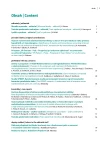Dangerous cucumbers – Leyll’s syndrome
Authors:
Ján Csomor 1; Bohuš Bunganič 1; Sergey Zakharov 2; Igor Pafčuga 3; Pavel Sedloň 1; Petr Urbánek 1
Authors‘ workplace:
Interní klinika 1. LF UK a Ústřední vojenská nemocnice – Vojenská fakultní nemocnice Praha
1; Toxikologické informační středisko Kliniky pracovního lékařství 1. LF UK a VFN Praha
2; Klinika popáleninové medicíny 3. LF UK a FN Královské Vinohrady Praha
3
Published in:
Vnitř Lék 2016; 62(1): 57-61
Category:
Case Reports
Overview
Leyll’s syndrome (syndrome of toxic epidermal necrolysis) is a rare disease, firstly described by Scottish doctor of medicine Allan Lyell in 1956. It is characterized by huge skin and mucosa necrolysis, which affects at least 30 % of body surface, and systemic symptoms. According to the frequency of the occurrence it is an extremely rare condition, with an incidence of 0.5–2 cases per million residents per year. Leyll’s syndrome is considered as a toxoallergic reaction, triggered mostly by some medication and it is associated with a very high mortality rate (in the literature reported between 30 to 90 %). Adequate and timely local and systemic treatment at the Intensive Care Unit or at the specialized clinic can improve the overall poor prognosis of the patients. In our case report we describe a very rare case of the Lyell’s syndrome after exposure to the antifungal organosulfur compound, which is widely used by the homegardners and farmers.
Key words:
bis-dithiocarbamates – Leyll’s syndrome – toxic epidermal necrolysis
Sources
1. Mockenhaupt M. The current understanding of Stevens-Johnson syndrome and toxic epidermal necrolysis. Expert Rev Clin Immunol 2011; 7(6): 803–813.
2. Nešpor D, Lipový B, Gregorová N. Cyklosporin A v terapii toxické epidermální nekrolýzy. Dermatol praxi 2011; 5(3): 156–159.
3. Cohen V, Stuart Bronze M (ed). Toxic Epidermal Necrolysis. Dostupné z WWW: <http://emedicine.medscape.com/article/229698-overview#showall>.
4. Beneš J et al. Infekční lékařství. Galén: Praha 2009. ISBN 978–80–7262–644–1.
5. Osthaus WA. Leyll- Syndrom. In: Haverkamp W, Herth F, Messmann H. Internistische Intensivmedizin: Methoden – Diagnose – Therapie. Thieme Georg Verlag: Stuttgart 2008. ISBN 978–3131406217.
6. Bastuji-Garin S, Fouchard N, Bertocchi M et al. SCORTEN: a severity-of-illness score for toxic epidermal necrolysis. J Invest Dermatol 2000; 115(2): 149–153.
7. Babini G. A case of erythroderma caused by zinc dithiocarbamate. Arch Ital Dermatol Venereol Sessuol 1966; 34: 230–238.
8. Piraccini BM, Cameli N, Peluso AM et al. A case of allergic contact dermatitis due to the pesticide maneb. Contact Dermatitis 1991; 24(5): 381.
9. Ellender RP, Peters CW, Albritton HL et al. Clinical considerations for epidermal necrolysis. Oschner J 2014; 14(3): 413–417.
10. Roujeau JC, Kelly JP, Naldi L et al. Medication Use and the Risk of Stevens-Johnsons Syndrome or Toxic Epidermal Necrolysis. N Engl J Med 1995; 333(24): 1600–1607.
11. Napoli B, D’Arpa N, Masellis M. The Treatment of Lyell’s Syndrome: our Experience. Ann Burns Fire Disasters 2006; 19(1): 33–35.
12. Egan CA, Grant WJ, Morris SE et al. Plasmapheresis as an adjunct treatment in toxic epidermal necrolysis. J Am Acad Dermatol 1999; 40(3): 458–461.
13. Schneck J, Fagot JP, Sekula P et al. Effects of treatment on the mortality of Stevens-Johnson syndrome and toxic epidermal necrolysis: A retrospective study on patients included in the prospective EuroSCAR Study. J Am Acad Dermatol 2008; 58(1): 33–40.
14. Lissia M, Mulas P, Bulla A et al. Toxic epidermal necrolysis (Lyell´s disease). Burns 2010; 36(2): 152–163.
15. Darlenski R, Kazandjieva J, Tsankov N. Systemic drug reactions with skin involvement: Stevens-Johnson syndrome, toxic epidermal necrolysis, and DRESS. Clin Dermatol 2015; 33(5): 538–541.
16. Hinc-Kasprzyk J, Polak-Krzemińska A, Ożóg-Zabolska I. Toxic epidermal necrolysis. Anaesthesiol Intensive Ther 2015; 47(3): 257–262.
17. Paulmann M, Mockenhaupt M. Severe drug-induced skin reactions: clinical features, diagnosis, etiology, and therapy. J Dtsch Dermatol Ges 2015; 13(7): 625–645.
18. Sun J, Liu J, Gong QL et al. Stevens-Johnsons Syndrome and toxic epidermal necrolysis: a multi-aspect comparative 7-year study from the People’s Republic of China. Drug Des Devel Ther 2014; 8: 2539–2547. Dostupné z DOI: <http://dx.doi.org/10.2147/DDDT.S71736>.
19. Vokurka J, Fassmann A, Zgažarová S et al. Stevens-Johnsonův syndrom a jeho projevy v ústní dutině. Prakt zub Lék 2010; 58(3): 39–44.
20. Matějovič M. Lyellův syndrom. Anest Intenziv Med 2013; 24(1): 42.
21. Šuca H, Tokarik M, Pafčuga I et al. Toxická epidermální nekrolýza – naše zkušenosti s celkovou i lokální léčbou. Hojení ran 2011; 5(2): 22–24.
22. Lipový B, Říhová H, Gregorová N et al. Toxická epidermální nekrolýza: přehled možností terapie. Hojení ran 2011; 5(4): 6–12.
Labels
Diabetology Endocrinology Internal medicineArticle was published in
Internal Medicine

2016 Issue 1
Most read in this issue
- Toxic epidermal necrolysis
- Changes in the prognosis and treatment of Waldenström macroglobulinemia. Literature overview and own experience
- Significance of alanine aminotransferase screening in blood donors for risk reduction of hepatitis B and C transmission by haemotherapy
- A rare case of mobile atherosclerotic plaque with a high embolic potential in the femoral artery
